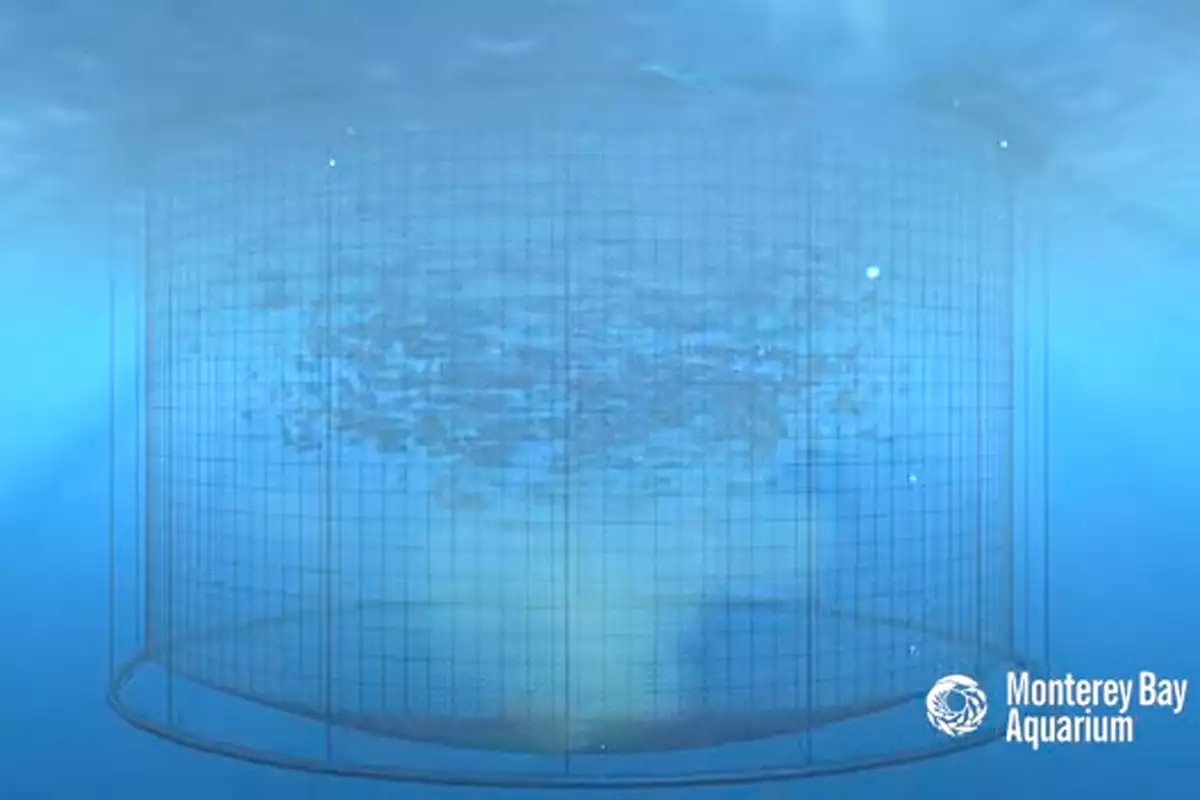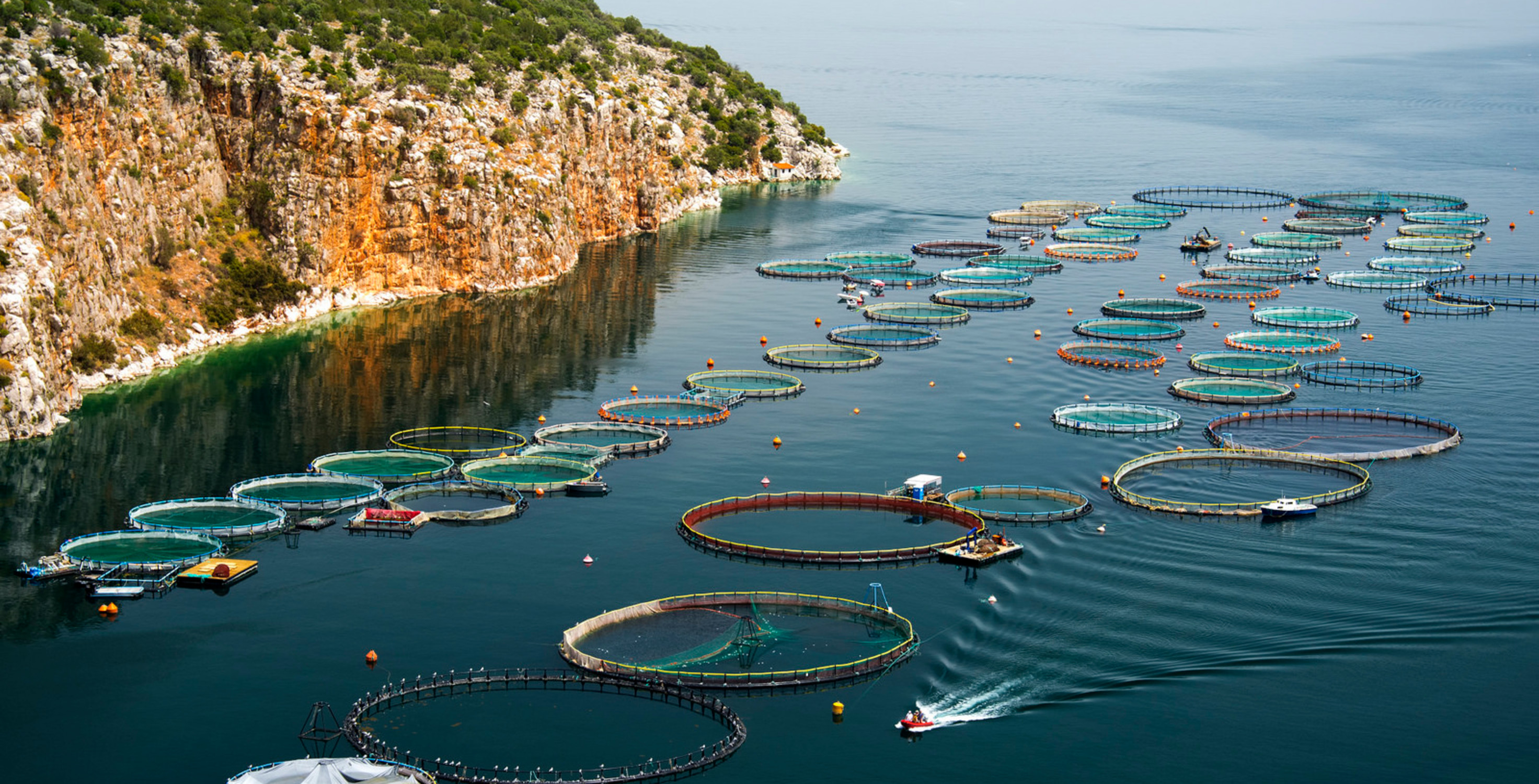Aquaculture and Mariculture
What is Aquaculture and Mariculture?
Aquaculture, otherwise known as fish farming, is a controlled cultivation of different types of fish, shellfish, and aquatic plants for commercial use. A subset of aquaculture is mariculture, which specifically refers to farming saltwater marine organisms (Kim, 2022). Mariculture is ~51% of worldwide aquaculture production and differs depending on what type of fish are being harvested: this can include cold water species like salmon, halibut, and cod, or warm water species, like wahoo, snapper, and conch, all of which are found in the US Virgin Islands (Phillips, 2009). Controlling overfishing, increasing profit, and creating jobs are all huge benefits of mariculture, but if done without proper regulations, it can harm the environment and raise ethical concerns (NOAA, n.d.). Right now, the USVI has very little investment in mariculture, but may slowly begin making progress in farming oysters. Increasing the production of sustainable mariculture has the potential to help preserve coral reefs, which are vital ecosystems in Saint John and the USVI for coastal protection, marine life, and human livelihood. There are several environmental trade-offs involved in the relationship between mariculture, coral reefs, and the well being of human society, but if done sustainably, fish farming could bring a lot of good to the Virgin Islands.
Aquaculture Methods
The methods used to cultivate different marine organisms can vary, as maricultures are not one size fits all. Open-net pens, which are pens placed directly into the ocean and allow water to flow in and out, are a common method for raising fish in saltwater environments to later be caught; however, these often lead to nutrient pollution, disease transmission, and habitat degradation. In contrast, off bottom culture methods such as big racks, suspended longlines, and raft systems, are used to grow seaweed and bivalves like oysters and mussels. These filter feeder organisms are attached to long lines or secured bags that hang in the water, allowing them to grow and help filter out excess nutrients until they are ready to be harvested. These typically have a lower impact on the environment, because they don’t require additional feed and provide filtration benefits.
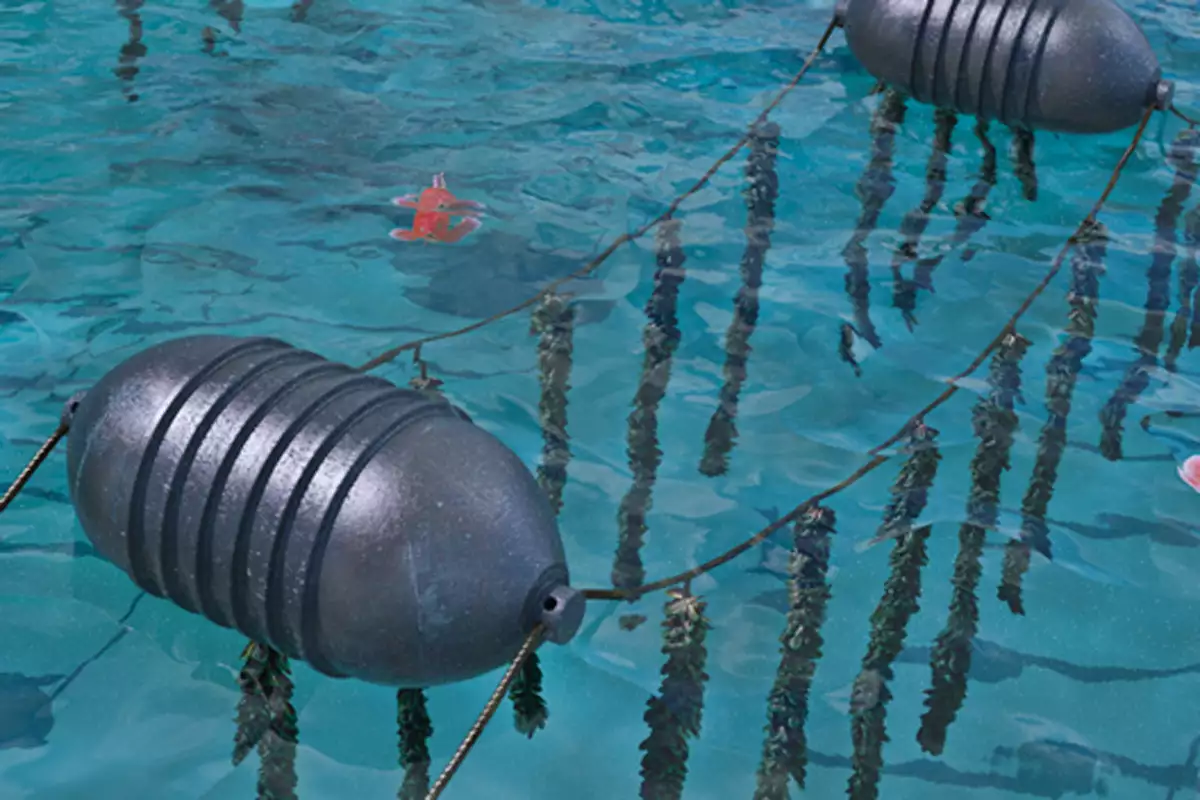
 Visuals of open net pens and off bottom culture often used in warm water mariculture(https://www.seafoodwatch.org/seafood-basics/fishing-and-farming-methods)
Visuals of open net pens and off bottom culture often used in warm water mariculture(https://www.seafoodwatch.org/seafood-basics/fishing-and-farming-methods)
Hatcheries raise juvenile species in controlled environments before being released/transferred to a different farming system or into the ocean for fisheries to harvest. This can, however, create concerns about mating or genetically mixing with wild populations, and weakening the species overall due to the skinnier, weaker nature of hatchery-raised fish.
Lastly, Recirculating Aquaculture Systems (RAS) are land-based infrastructures that recycle water and minimize waste discharge, proving to have better environmental impacts and prevent the spread of disease. While ponds and raceways are also used in aquaculture, they are less common in saltwater mariculture systems near coral reefs. Understanding the approaches to aquaculture technology is essential to assessing benefits and risks to coral reef ecosystems, and human society (Seafood Watch, n.d.).
Aquaculture & Mariculture in the USVI
Mariculture is a developing industry in the U.S. Virgin Islands. Historically, the islands have relied on tourism as the main industry but as climate change threatens the reefs and natural resources on the island, people are looking to mariculture as a new opportunity. As mariculture is such a new type of production for the islands, there is a lot of work being done in research, education, and developing policies regarding the industry. The University of the Virgin Islands recently opened an aquaculture & aquaponics department where students are being taught about production and conducting research on local aquaculture. The majority of previous research through the University has been done on Tilapia and freshwater aquaculture (Rokocy, 2007). Though their aquaponics system is revolutionary for aquaculture on the islands, their systems are on land and use freshwater. Freshwater on the islands – especially on St. John – is extremely limited, so more research needs to be done on saltwater aquaculture around the archipelago. Sennai Habtes is currently the Bureau Chief of Fisheries for the Virgin Islands Department of Planning and Natural Resources (Division of Fish and Wildlife) but he used to be a professor of Marine and Environmental Studies at the University of the Virgin Islands. As previously mentioned, he reinforced the idea that freshwater is very limited on the islands and the impact that has on the local aquaculture. Furthermore, he emphasized how it is difficult to raise saltwater fish because their breeding requirements are very particular. Creating the perfect conditions for these fish is very costly, both in energy and monetarily. For these reasons, he explained that it would be easier to start the saltwater aquaculture industry in the Virgin Islands with something cheaper and less finicky such as bivalves. Impressively, Mr. Habtes wrote a grant proposal and was approved to buy a Oyster Seed Holdings Mobile Oyster Hatchery. These hatcheries are made from modified and outfitted shipping containers, and are completely self contained hatcheries. What makes these hatcheries different is that they’re completely mobile and can be modified to fit the conditions needed for different species of fish, bivalves, or other aquaculture productions. Pictured below is a rendering of what these hatcheries can look like.
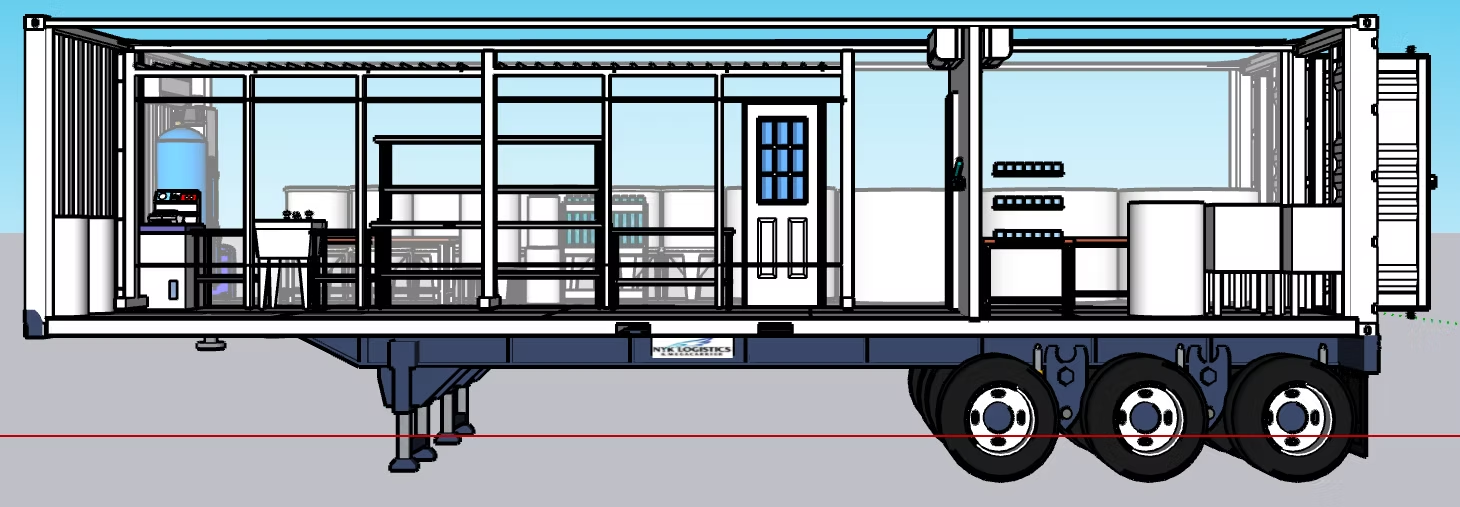

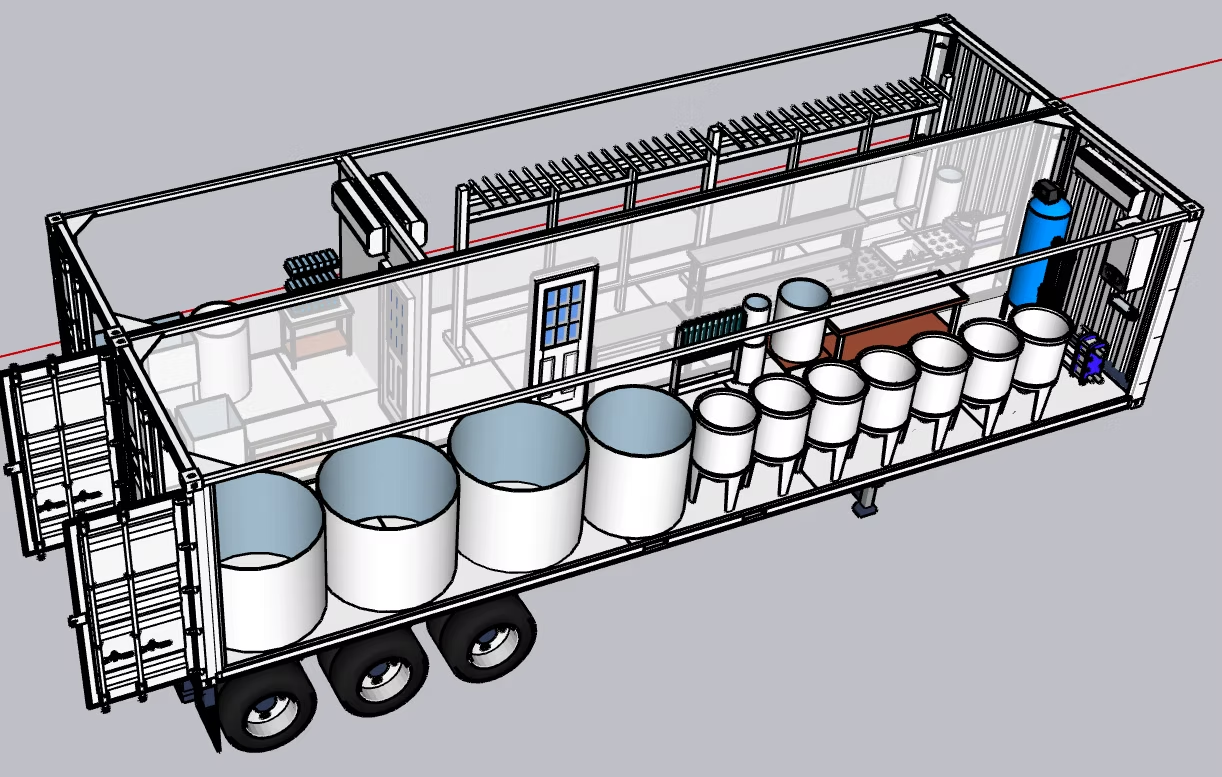
 (Oyster Seed Holdings, 2024)
(Oyster Seed Holdings, 2024)
Unfortunately, he simply doesn’t have the workforce or the money to scale up this project and expand it to its full potential. This is where the expansion of education and research on aquaculture in the Virgin Islands becomes necessary. Mr. Habtes says that he hopes the new program in aquaculture & aquaponics at the UVI will draw in students that want to graduate and work in this industry.
As the aquaculture industry begins to bloom in the U.S. Virgin Islands, the local government is working to create rules, regulations, and policies for the industry. The Department of Planning and Natural Resources, Division of Fish and Wildlife is currently working on this policy: Virgin Islands Aquaculture Rules and Regulations (Oriol, 2024). Some of the questions they are trying to answer include: where will this occur, what will be farmed, and who can participate in aquaculture in the USVI. Under these regulations, aquaculture can occur in AOA’s or Agriculture Opportunity Areas. As defined by NOAA, “An Aquaculture Opportunity Area (AOA) is a defined geographic area that has been evaluated to determine its potential suitability for commercial aquaculture” (National Oceanic and Atmospheric Administration, n.d.). They use a combination of “scientific analysis and public engagement to identify areas that are environmentally, socially, and economically appropriate for commercial aquaculture” (National Oceanic and Atmospheric Administration, n.d.). The USVI is currently in the process of determining these areas and has held public meetings to gain community insight on the topic. Secondly, they are still determining what species can be farmed in this area. As Mr. Habtes said, it is cheaper to start the industry with easier species like bivalves and not finicky fish. However, there are some fish species like Cobia and Mutton Snapper they’re looking into producing. Finally, the commission is also still working on deciding who can participate in the new industry. Likely, it will be a partnership between private companies and the government. However, there will be challenges with this new industry and regulating it. Aquaculture is beneficial in reducing overfishing and consumption of land based resources but it can be damaging to the underwater ecosystem if done incorrectly. The commission on aquaculture has to be very specific in their rules and regulations to avoid environmental degradation due to aquaculture.
Impacts of Mariculture on Coral Reef Ecosystems
Despite a limited amount of research into the impacts of mariculture on coral reef ecosystems, it is evident that there are both ecological benefits and drawbacks associated with the practice. Mariculture positively impacts coastal communities by generating greater production of the commercial goods that those communities rely on, and it has an array of ecological benefits for the reefs. It is hypothesized that mariculture, when properly executed, could increase the diversity of the species farmed (Lester et al. 2024).
Research shows that mariculture helps mitigate climate change by resulting in carbon sequestration, or, in other words, the capturing and storage of atmospheric carbon dioxide (Liu et al. 2024). One study showed that in just one hectare of a sustainable seaweed and shellfish aquaculture farm, a half a ton of nitrogen is removed from the water and the harmful impacts of nitrification, including water pollution, excessive algae growth, global warming, and more, are reduced (Restorative Aquaculture for Nature and Communities, n.d.). Seaweed and shellfish have also been shown to decrease levels of phosphorous in the water as they grow and develop, and seaweed can purify wastes brought into the water from tides and runoffs (Liu et al. 2024).
Finally, mariculture as a means of production aligns with several of the Sustainable Development Goals outlined by the United Nations in 2015. SDG2 and 3 are no hunger and good-health and well-being, which are tackled by cultivating seafood as a source of protein and nutrients. A growing mariculure industry would create jobs which aligns with SDG1’s goal of eliminating poverty. If the mariculture operation is properly developed and monitored, it would fulfill SDG12 and SDG14 which favor responsible consumption and production of goods and the protection of aquatic life, respectively. As mentioned previously, if climate friendly species are cultivated, green house gases could be reduced and carbon sequestration would occur, which aligns with SDG13 (Liu et al. 2024).

 (Restorative Aquaculture for Nature and Communities, n.d.)
With that being said, mariculture has been shown to have negative impacts on aquatic ecosystems, including coral reefs. A study conducted in 2002 in the Philippines showed that coral reefs near floating sea cages housing milkfish, a saltwater fish, exhibited an array of health issues. These issues are due to the eutrophic conditions triggered by the mariculture production, resulting in increased phosphate, ammonium, and nitrate levels. The chemical byproducts of mariculture have also harmed seagrass populations and caused black band disease in some transplanted coral species (Quimpo et al. 2020).
(Restorative Aquaculture for Nature and Communities, n.d.)
With that being said, mariculture has been shown to have negative impacts on aquatic ecosystems, including coral reefs. A study conducted in 2002 in the Philippines showed that coral reefs near floating sea cages housing milkfish, a saltwater fish, exhibited an array of health issues. These issues are due to the eutrophic conditions triggered by the mariculture production, resulting in increased phosphate, ammonium, and nitrate levels. The chemical byproducts of mariculture have also harmed seagrass populations and caused black band disease in some transplanted coral species (Quimpo et al. 2020).
In 2007, researchers investigated the impact of an offshore mariculture operation on sediment composition along the coast of Oahu, Hawaii. Their data showed that ammonia levels were 30-46% higher than the control samples, sulfate reducing bacteria counts were 36% higher than the control, and organic carbon levels were 25-37% lower than the control (Yoza et al. 2007). In a separate study investigating the mechanisms by which sediment causes damage to inshore reefs, researchers advised, “it is important for coastal management to understand that it is not sedimentation per se but rather the enrichment of coastal areas with organic matter that can be strongly detrimental for coral survival on inshore coral reefs” (Weber et al. 2012). Indeed, when sediments and nutrients aggregate in the water and fall over corals— even if in thin layers— it can kill the coral in about 24 hours, causing habitat destruction and harming the biodiversity of the coral reef (Weber et al. 2012).
Impacts of Mariculture on Humans
As with most any developing industry, mariculture provides significant economic opportunities by supporting the livelihoods mariculture farmers, while also creating jobs and businesses for coastal and island communities (Slater 2017). Since conditions ideal for mariculture farming do not exist all over the world, these industries offer valuable trade opportunities and contribute to the economic resiliency of these regions. Mariculture helps avoid the overfishing of many wild fish stocks, economically supporting both practices (Betz 2023). Additionally, aquaculture can be used to cultivate high-value resources such as pearls and other goods for consumption, further enhancing its economic potential.
Many types of mariculture, but especially seaweed and shellfish farming, offer several environmental benefits. These practices can help remove pollutants from the water, improving overall marine health. Seaweed and shellfish also absorb excess nutrients, such as nitrogen and phosphorus, which helps reduce the occurrence of harmful algal blooms (Cho 2011). Farming large populations of these species would help remove huge proportions of harmful nutrients at a faster rate. Additionally, bivalve farming produces lower emissions than many other farming practices, making it a promising option in the sustainability realm (Kim 2022).
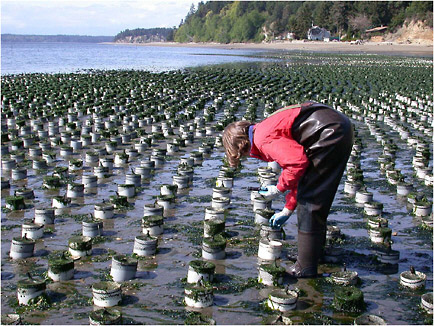
 This is an example of bivalve mariculture use in an intertidal zone in Washington state. Photo credits to Jennifer Ruesink, University of Washington.
Though the mariculture industry is still in early phases of development in many parts of the world, it holds the ability to one day supply a significant portion of the world’s seafood. However, action must be swift and mariculture developments must be quickly developed to dodge major impacts of climate change and warming ocean temperatures on fish and shellfish populations (Responsible Seafood Advocate 2022). With time, the industry will help meet the growing demand for protein-rich foods. Fish and shellfish are not only a highly nutritious source of protein, but they also provide essential vitamins and minerals that contribute to a healthy diet. A growing mariculture industry would eventually lead to lower seafood prices, making diets, especially of coastal populations, more affordable, accessible, and sustainable.
This is an example of bivalve mariculture use in an intertidal zone in Washington state. Photo credits to Jennifer Ruesink, University of Washington.
Though the mariculture industry is still in early phases of development in many parts of the world, it holds the ability to one day supply a significant portion of the world’s seafood. However, action must be swift and mariculture developments must be quickly developed to dodge major impacts of climate change and warming ocean temperatures on fish and shellfish populations (Responsible Seafood Advocate 2022). With time, the industry will help meet the growing demand for protein-rich foods. Fish and shellfish are not only a highly nutritious source of protein, but they also provide essential vitamins and minerals that contribute to a healthy diet. A growing mariculture industry would eventually lead to lower seafood prices, making diets, especially of coastal populations, more affordable, accessible, and sustainable.
Big Picture
Mariculture is an exciting opportunity to promote economic growth, food production and reduce the impacts of overfishing in the USVI and beyond. However, with an industry that works hand and hand with the environment, careful management is necessary; the survival of coral reefs in part depends on how people choose to farm fish and other sea creatures. With smart, well enforced policies and continual research and funding, agriculture can serve environmental protection, not degradation.
References (in order of appearance):
- Kim, H. (2022, November 16). What is Mariculture and what are its environmental effects?. Sentient. (https://sentientmedia.org/mariculture ) Phillips, M. (2008, December 2). Mariculture Overview. Encyclopedia of Ocean Sciences (Second Edition). (https://www.sciencedirect.com/science/article/abs/pii/B9780123744739007529 )
- NOAA Fisheries. (n.d.). Marine Aquaculture. (https://www.fisheries.noaa.gov/insight/marine-aquaculture#:~:text=other%20marine%20fish.-,What%20can%20marine%20aquaculture%20do%20for%20the%20economy?,of%20jobs%20in%20coastal%20communities)
- Monterey Bay Aquarium. (n.d.). Fishing and Farming Methods. Seafoodwatch.org. (https://www.seafoodwatch.org/seafood-basics/fishing-and-farming-methods)
- University of the Virgin Islands. (n.d.). Research, Biofloc systems. Research. (https://www.uvi.edu/research/agricultural-experiment-station/aquaculture-home/biofloc-systems/research.html)
- Oyster Seed. (n.d.). OSH Mobile Oyster Hatchery Concept. OSH 2.0. (https://www.oshoyster.com/moh)
- Oriol, J.-P. L. (2024). Virgin Islands Aquaculture Rules And Regulations Title 12, Chapter 9A, Subchapter 327. DPNR. (https://dpnr.vi.gov/wp-content/uploads/2023/09/VIDPNR_FY22-23-CW-DW_IUP_Draft_09-10-23.pdf)
- NOAA Fisheries. (n.d.). Aquaculture: Aquaculture opportunity areas. Aquaculture | NOAA Fisheries. (https://www.fisheries.noaa.gov/topic/aquaculture/aquaculture-opportunity-areas)
- Lester, S., Gentry, R., & Froehlic, H. (2023, December 30). The role of marine aquaculture in contributing to the diversity and stability of U.S. seafood production. Marine Policy. (https://www.sciencedirect.com/science/article/abs/pii/S0308597X23005274)
- Liu, C., Liu, G., Cristiano, S., Ulgiati, S., Xu, L., & Yang, Z. (2024, April 26). Investigating potential ecological benefits from mariculture. Earth’s Future, 12, e2023EF003766. (https://doi.org/10.1029/2023EF003766)
- The Nature Conservancy . (2023, August 21). How restorative aquaculture helps nature and communities thrive. The Nature Conservancy. (https://www.nature.org/en-us/what-we-do/our-insights/perspectives/restorative-aquaculture-for-nature-and-communities/#:~:text=Local%20Benefits%2C%20Global%20Scale,seen%20in%20wild%20kelp%20forests)
- Quimpo, T. J., Ligson, C., Manogan, D., Requilme, J., Albelda, R., Conaco, C., & Cabaitan, P. (2020, March 4). Fish farm effluents alter reef benthic assemblages and reduce coral settlement. Marine Pollution Bulletin. (https://www.sciencedirect.com/science/article/abs/pii/S0025326X20301430#:~:text=This%20has%20led%20to%20persistent,et%20al.%2C%202008)
- Yoza, B., Harada, R., Nihous, G., Li, Q., & Masutani, S. (2007, January). Impact of mariculture on microbial diversity in sediments near open ocean farming of Polydactylus Sexfilis. Ecological Indicators. (https://www.sciencedirect.com/science/article/abs/pii/S1470160X05001135#:~:text=Mariculture%20is%20known%20to%20contribute,were%20Proteobacteria%2C%20Chloroflexi%20and%20Bacteroidetes)
- Weber, M., de Beer, D., Lott, C., & Fabricus, K. (2012, May 21). Mechanisms of damage to corals exposed to sedimentation | PNAS. PNAS. (https://www.pnas.org/doi/10.1073/pnas.1100715109)
- World Aquaculture Society. (2017, August 7). Societal And Economic Impacts of Aquaculture. (https://www.was.org/articles/Societal-and-Economic-Impacts-of-Aquaculture.aspx)
- Betz, T. (2023, November 10). 4 economic benefits of Aquaculture. Maine Aquaculture Association. (https://maineaqua.org/4-economic-benefits-of-aquaculture/)
- Cho, R. (2011, September). The seaweed and shellfish solution. E Magazine. Retrieved May 31, 2025, from (https://reneecho.wordpress.com/wp-content/uploads/2011/02/pub-article.pdf.)
- National Research Council. (2010). Ecosystem concepts for sustainable bivalve mariculture. 4 Bivalve Mariculture Contrasted with Wild Fisheries | Ecosystem Concepts for Sustainable Bivalve Mariculture | The National Academies Press. (https://nap.nationalacademies.org/read/12802/chapter/6)
- Responsible Seafood Advocate. (2024, September 30). Expanding Mariculture “vital” to world’s food security, study finds. Global Seafood Alliance. (https://www.globalseafood.org/advocate/expanding-mariculture-vital-to-worlds-food-security-study-finds/)
- FAIRR. (2019, April 4). Aquaculture and marine farming. (https://www.fairr.org/resources/knowledge-hub/key-terms/aquaculture-marine-farming)
References (alphabetically):
- Betz, T. (2023, November 10). 4 economic benefits of Aquaculture. Maine Aquaculture Association. (https://maineaqua.org/4-economic-benefits-of-aquaculture/)
- Cho, R. (2011, September). The seaweed and shellfish solution. E Magazine. Retrieved May 31, 2025, from (https://reneecho.wordpress.com/wp-content/uploads/2011/02/pub-article.pdf.)
- FAIRR. (2019, April 4). Aquaculture and marine farming. (https://www.fairr.org/resources/knowledge-hub/key-terms/aquaculture-marine-farming)
- Kim, H. (2022, November 16). What is Mariculture and what are its environmental effects?. Sentient. (https://sentientmedia.org/mariculture)
- Lester, S., Gentry, R., & Froehlic, H. (2023, December 30). The role of marine aquaculture in contributing to the diversity and stability of U.S. seafood production. Marine Policy. (https://www.sciencedirect.com/science/article/abs/pii/S0308597X23005274)
- Liu, C., Liu, G., Cristiano, S., Ulgiati, S., Xu, L., & Yang, Z. (2024, April 26). Investigating potential ecological benefits from mariculture. Earth’s Future, 12, e2023EF003766. (https://doi.org/10.1029/2023EF003766)
- Monterey Bay Aquarium. (n.d.). Fishing and Farming Methods. Seafoodwatch.org. (https://www.seafoodwatch.org/seafood-basics/fishing-and-farming-methods)
- National Research Council. (2010). Ecosystem concepts for sustainable bivalve mariculture. 4 Bivalve Mariculture Contrasted with Wild Fisheries | Ecosystem Concepts for Sustainable Bivalve Mariculture | The National Academies Press. (https://nap.nationalacademies.org/read/12802/chapter/6)
- The Nature Conservancy . (2023, August 21). How restorative aquaculture helps nature and communities thrive. The Nature Conservancy. (https://www.nature.org/en-us/what-we-do/our-insights/perspectives/restorative-aquaculture-for-nature-and-communities/#:~:text=Local%20Benefits%2C%20Global%20Scale,seen%20in%20wild%20kelp%20forests)
- NOAA Fisheries. (n.d.-a). Aquaculture: Aquaculture opportunity areas. Aquaculture | NOAA Fisheries. (https://www.fisheries.noaa.gov/topic/aquaculture/aquaculture-opportunity-areas)
- NOAA Fisheries. (n.d.-b). Marine Aquaculture. (https://www.fisheries.noaa.gov/insight/marine-aquaculture#:~:text=other%20marine%20fish.-,What%20can%20marine%20aquaculture%20do%20for%20the%20economy?,of%20jobs%20in%20coastal%20communities)
- Oriol, J.-P. L. (2024). Virgin Islands Aquaculture Rules And Regulations Title 12, Chapter 9A, Subchapter 327. DPNR. (https://dpnr.vi.gov/wp-content/uploads/2023/09/VIDPNR_FY22-23-CW-DW_IUP_Draft_09-10-23.pdf)
- Oyster Seed. (n.d.). OSH Mobile Oyster Hatchery Concept. OSH 2.0. (https://www.oshoyster.com/moh)
- Phillips, M. (2008a, December 2). Mariculture Overview. Encyclopedia of Ocean Sciences (Second Edition). (https://www.sciencedirect.com/science/article/abs/pii/B9780123744739007529)
- Phillips, M. (2008b, December 2). Mariculture Overview. Encyclopedia of Ocean Sciences (Second Edition). (https://www.sciencedirect.com/science/article/abs/pii/B9780123744739007529)
- Quimpo, T. J., Ligson, C., Manogan, D., Requilme, J., Albelda, R., Conaco, C., & Cabaitan, P. (2020, March 4). Fish farm effluents alter reef benthic assemblages and reduce coral settlement. Marine Pollution Bulletin. (https://www.sciencedirect.com/science/article/abs/pii/S0025326X20301430#:~:text=This%20has%20led%20to%20persistent,et%20al.%2C%202008)
- Responsible Seafood Advocate. (2024, September 30). Expanding Mariculture “vital” to world’s food security, study finds. Global Seafood Alliance. (https://www.globalseafood.org/advocate/expanding-mariculture-vital-to-worlds-food-security-study-finds/) University of the Virgin Islands. (n.d.). Research, Biofloc systems. Research. (https://www.uvi.edu/research/agricultural-experiment-station/aquaculture-home/biofloc-systems/research.html)
- Weber, M., de Beer, D., Lott, C., & Fabricus, K. (2012, May 21). Mechanisms of damage to corals exposed to sedimentation | PNAS. PNAS. (https://www.pnas.org/doi/10.1073/pnas.1100715109)
- World Aquaculture Society. (2017, August 7). Societal And Economic Impacts of Aquaculture. (https://www.was.org/articles/Societal-and-Economic-Impacts-of-Aquaculture.aspx)
- Yoza, B., Harada, R., Nihous, G., Li, Q., & Masutani, S. (2007, January). Impact of mariculture on microbial diversity in sediments near open ocean farming of Polydactylus Sexfilis. Ecological Indicators. (https://www.sciencedirect.com/science/article/abs/pii/S1470160X05001135#:~:text=Mariculture%20is%20known%20to%20contribute,were%20Proteobacteria%2C%20Chloroflexi%20and%20Bacteroidetes)
